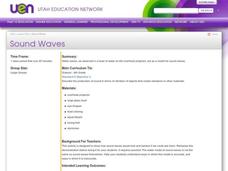Curated OER
Math in Science-Sound Reasoning
In this basic math skills worksheet, students use division, decimals and multiplication to calculate the speed of sound in water and compare it to the speed in air. They calculate distances sound travels in water and the time it takes...
Curated OER
The Magic School Bus In the Haunted House
Students learn along with Ms. Frizzle's class. In this Magic School Bus lesson plan, students explore the science of sound as they complete a science experiment in small groups.
Curated OER
Strange Sounds
Students investigate sound as a form of energy. In this energy, forces, and sound lesson plan, students explore how different sounds may be made as they make a variety of materials vibrate. Students observe the effects of vibrations and...
Curated OER
Sound
In this sound worksheet, students understand how sound is created and how the human ear "hears." Students compare the frequency, amplitude, and speed of sound. Then students complete 10 matching, 7 fill in the blank, and 11 short answer...
Curated OER
Sound Waves Simulation Worksheet
In this sound wave worksheet, students go to http://phet.colorado.edu/new/simulations/sims.php?sim=Sound and run the simulation to complete 28 short answer question.
Curated OER
The Science of Sound
For this explanation of sound worksheet, students discover what sound is, how different sounds are made, frequency, how sound travels, how we hear, and a summarization. In this physical science worksheet, students answer ten...
Curated OER
Scientific Methods in Biology
For this scientific methods worksheet, students will study a graph comparing the hearing range of humans to the range of sounds elephants make. Based on this graph, students will complete 3 short answer questions.
Curated OER
The Nature of Sound
In this science worksheet, students use basic scientific concepts to complete the series of puzzles that are intended to increase science literacy while focusing upon sound by listening to the tones on a telephone.
Curated OER
The Insect World
Students investigate how insects communicate since they cannot use their mouths for producing sound like humans can. In small groups, they devise a way to make an insect-like sound using body parts other than their mouths or vocal...
Curated OER
Seeing the Seafloor Using Sound - Multibeam Sidescan Sonar
Students are told that sound is not just stuff that our ears hear. They are explained that it is a tool for measuring and looking at objects in a new way. Students are introduced to sound waves and sonar imaging. They are explained...
Curated OER
Sound
Fifth graders explore and examine the basic properties of sound. In pairs, they speak through a balloon and listen to the sound vibrations, and listen to a ticking clock or watch through a variety of materials and identify the...
Curated OER
Sound
Young scholars identify sources and importance of sound, discuss sounds heard on way to school, explain why sound waves can be "seen", and participate in various classroom activities and experiments that illustrate how sound travels.
Curated OER
Sound Energy
Sixth graders understand properties and behavior of heat, light, and sound. They describe the production of sound in terms of vibration of objects that create vibrations in other materials. Students describe how sound is made from...
Curated OER
Pigs Love Pink Pancakes
Students explore the grapheme along with phoneme it represents. The teacher teaches letter reconginition by having the students write the letter and practice the sound. This helps studens investigate the letter faster (p). Students...
Curated OER
Our Own Water Music
Students listen to a portion of Handel's Water Music Suite and hypothesize about what would happen if you tapped on the edge of a glass with varying levels of water. They experiment with the glasses and, in small groups, compose their...
Curated OER
The Halls are Alive with the Sound of Music
Students discuss physical places in which had good or bad acoustics. After reading an article, they discover the relationship between the physics of sound and concert hall acoustics. They calculate the speed of sound and compare their...
Curated OER
Sound for Sight
Students study echolocation and understand how dolphins use it to locate prey, escape predators, and navigate their environment. They view a video, "In the Wild-Dolphins with Robin Williams" and see first hand how dolphins communicate. ...
Curated OER
TE Activity: Sound Line
Students investigate the decibel readings of various noises. They determine why high-level readings damage hearing. Students arrange sound from the lowest to highest decibel levels when they written on a piece of paper.
Alabama Learning Exchange
Echolocation Stations: Exploring Sound
Fourth graders explore the concept of echolocation during a unit on whales. They listen to the book and watch the Reading Rainbow video for "Humphrey: The Wayward Whale," explore various websites, and conduct experiments to demonstrate...
Curated OER
Music Technology: Adding a Voice to a Cartoon
Students add their voice to a cartoon character and review sound waves using music technology software. They record specific information into the computer using a microphone and import their voice into the Flash program and apply it to...
Curated OER
Sound Waves
Students observe how sound waves would look and behave if we could see them. They determine ways the model is accurate and inaccurate based on actual sound waves.
Curated OER
When It Comes to Sound, I'm All Ears!
Students discover how sound is produced and how sound travels. Through inquiry, problem solving and hands-on activities, students explore high and low sounds and the mediums in which sound travels best.
Curated OER
From Bats to Babies: Ultrasound
Young scholars research and analyze sound waves and how an ultrasound works to image a baby in utero. They explore various websites, complete worksheets, and write a paragraph describing a demonstration they view in the classroom.
Curated OER
Keep It Quiet!
Fourth graders study about sound waves and how they behave in various media. They create a soundproofed container. They explain that velocity describes a change in distance over time.

























